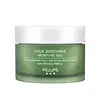What's inside
What's inside
 Key Ingredients
Key Ingredients

 Benefits
Benefits

 Concerns
Concerns

No concerns
 Ingredients Side-by-side
Ingredients Side-by-side

Water
Skin ConditioningGlycerin
HumectantBetaine
HumectantPhenoxyethanol
PreservativeSaccharide Isomerate
HumectantIsononyl Isononanoate
EmollientCarbomer
Emulsion StabilisingSodium Acrylate/Sodium Acryloyldimethyl Taurate Copolymer
Emulsion StabilisingIsohexadecane
EmollientPotassium Hydroxide
BufferingChlorphenesin
AntimicrobialDisodium EDTA
Polysorbate 80
EmulsifyingButyrospermum Parkii Butter
Skin ConditioningCentella Asiatica Leaf Extract
Skin ConditioningSorbitan Oleate
EmulsifyingHydrolyzed Hyaluronic Acid
HumectantTocopheryl Acetate
AntioxidantAloe Barbadensis Leaf Extract
EmollientCitric Acid
BufferingSodium Citrate
BufferingButylene Glycol
HumectantAlteromonas Ferment Extract
Skin ConditioningSodium Benzoate
MaskingWater, Glycerin, Betaine, Phenoxyethanol, Saccharide Isomerate, Isononyl Isononanoate, Carbomer, Sodium Acrylate/Sodium Acryloyldimethyl Taurate Copolymer, Isohexadecane, Potassium Hydroxide, Chlorphenesin, Disodium EDTA, Polysorbate 80, Butyrospermum Parkii Butter, Centella Asiatica Leaf Extract, Sorbitan Oleate, Hydrolyzed Hyaluronic Acid, Tocopheryl Acetate, Aloe Barbadensis Leaf Extract, Citric Acid, Sodium Citrate, Butylene Glycol, Alteromonas Ferment Extract, Sodium Benzoate
Water
Skin ConditioningGlycerin
HumectantPentaerythrityl Tetraisostearate
EmollientGlycereth-26
HumectantDipropylene Glycol
Humectant1,2-Hexanediol
Skin ConditioningCarbomer
Emulsion StabilisingButylene Glycol
HumectantTrehalose
HumectantTromethamine
BufferingCaprylyl Glycol
EmollientEthylhexylglycerin
Skin ConditioningAmmonium Acryloyldimethyltaurate/Vp Copolymer
Allantoin
Skin ConditioningPentylene Glycol
Skin ConditioningSodium Hyaluronate
HumectantDisodium EDTA
Centella Asiatica Extract
CleansingMadecassoside
AntioxidantGlyceryl Glucoside
HumectantCentella Asiatica Leaf Extract
Skin ConditioningCitrullus Lanatus Fruit Extract
Skin ConditioningAsiaticoside
AntioxidantTocopherol
AntioxidantLens Esculenta Fruit Extract
Skin ConditioningPyrus Malus Fruit Extract
Skin ConditioningSodium Lactate
BufferingSodium PCA
HumectantSodium Benzoate
MaskingPotassium Sorbate
PreservativeWater, Glycerin, Pentaerythrityl Tetraisostearate, Glycereth-26, Dipropylene Glycol, 1,2-Hexanediol, Carbomer, Butylene Glycol, Trehalose, Tromethamine, Caprylyl Glycol, Ethylhexylglycerin, Ammonium Acryloyldimethyltaurate/Vp Copolymer, Allantoin, Pentylene Glycol, Sodium Hyaluronate, Disodium EDTA, Centella Asiatica Extract, Madecassoside, Glyceryl Glucoside, Centella Asiatica Leaf Extract, Citrullus Lanatus Fruit Extract, Asiaticoside, Tocopherol, Lens Esculenta Fruit Extract, Pyrus Malus Fruit Extract, Sodium Lactate, Sodium PCA, Sodium Benzoate, Potassium Sorbate
 Reviews
Reviews

Ingredients Explained
These ingredients are found in both products.
Ingredients higher up in an ingredient list are typically present in a larger amount.
Butylene Glycol (or BG) is used within cosmetic products for a few different reasons:
Overall, Butylene Glycol is a safe and well-rounded ingredient that works well with other ingredients.
Though this ingredient works well with most skin types, some people with sensitive skin may experience a reaction such as allergic rashes, closed comedones, or itchiness.
Learn more about Butylene GlycolCarbomer is a polymer of acrylic acid. Its main role is to create a gel consistency.
A high amount of carbomer can cause pilling or balling up of products. Don't worry, most products contain 1% or less of carbomer.
Centella Asiatica Leaf Extract comes from the leaves of an herb plant native to Southeast Asia. Centella Asiatica is rich in antioxidants and amino acids. It can help reduce irritation and soothe the skin.
Many active components found in centella asiatica, such as Madecassic Acid and Asiaticoside, encourage the skin to naturally produce hyaluronic acid. This helps keep our skin hydrated. Many of these components also show antioxidant activity and may help reduce the signs of aging.
Research shows centella asiatica can help increase Type I collagen production by increasing fibroblast production. Fibroblast helps form connective tissue.
The combination of all these properties makes centella asiatica leaf extract effective at soothing the skin.
Other components of centella asiatica leaf extract include Vitamin A, vitamin C, several B vitamins, and Asiatic Acid.
Recent studies found madecassoside may help prevent damage from UV rays by preventing UV-induced inflammation. Further research is needed.
This plant has been used as a medicine and in food for many centuries. As a medicine, it is used to treat burns, scratches, and wounds.
Learn more about Centella Asiatica Leaf ExtractDisodium EDTA plays a role in making products more stable by aiding other preservatives.
It is a chelating agent, meaning it neutralizes metal ions that may be found in a product.
Disodium EDTA is a salt of edetic acid and is found to be safe in cosmetic ingredients.
Learn more about Disodium EDTAGlycerin is already naturally found in your skin. It helps moisturize and protect your skin.
A study from 2016 found glycerin to be more effective as a humectant than AHAs and hyaluronic acid.
As a humectant, it helps the skin stay hydrated by pulling moisture to your skin. The low molecular weight of glycerin allows it to pull moisture into the deeper layers of your skin.
Hydrated skin improves your skin barrier; Your skin barrier helps protect against irritants and bacteria.
Glycerin has also been found to have antimicrobial and antiviral properties. Due to these properties, glycerin is often used in wound and burn treatments.
In cosmetics, glycerin is usually derived from plants such as soybean or palm. However, it can also be sourced from animals, such as tallow or animal fat.
This ingredient is organic, colorless, odorless, and non-toxic.
Glycerin is the name for this ingredient in American English. British English uses Glycerol/Glycerine.
Learn more about GlycerinSodium Benzoate is a preservative. It's used in both cosmetic and food products to inhibit the growth of mold and bacteria. It is typically produced synthetically.
Both the US FDA and EU Health Committee have approved the use of sodium benzoate. In the US, levels of 0.1% (of the total product) are allowed.
Sodium benzoate works as a preservative by inhibiting the growth of bacteria inside of cells. It prevents the cell from fermenting a type of sugar using an enzyme called phosphofructokinase.
It is the salt of benzoic acid. Foods containing sodium benzoate include soda, salad dressings, condiments, fruit juices, wines, and snack foods.
Studies for using ascorbic acid and sodium benzoate in cosmetics are lacking, especially in skincare routines with multiple steps.
We always recommend speaking with a professional, such as a dermatologist, if you have any concerns.
Learn more about Sodium BenzoateWater. It's the most common cosmetic ingredient of all. You'll usually see it at the top of ingredient lists, meaning that it makes up the largest part of the product.
So why is it so popular? Water most often acts as a solvent - this means that it helps dissolve other ingredients into the formulation.
You'll also recognize water as that liquid we all need to stay alive. If you see this, drink a glass of water. Stay hydrated!
Learn more about Water